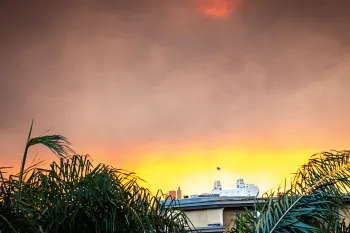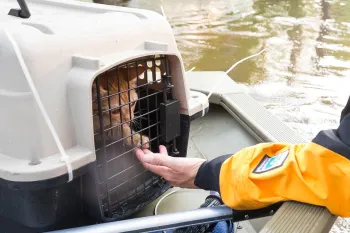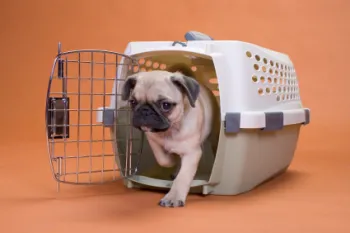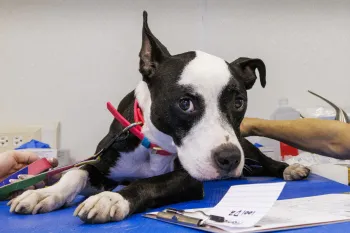This month, we have been spotlighting our disaster response and preparedness work around the world. I recently reflected on our presence on Kangaroo Island in early 2020, after devastating bushfires killed or displaced an estimated 3 billion animals there. The tragedy of those bushfires is just one of so many emergencies Adam Parascandola, vice president of the Animal Rescue Team here at Humane World for Animals, has witnessed. Whether it’s an earthquake, hurricane, tornado, typhoon or flood, Adam and his colleagues determine how we can help in crisis situations. Sometimes it’s a boots-on-the-ground approach, as in Kangaroo Island, and other times it’s through sending support from a distance. Here, Adam reflects on the six months that have passed since the wildfires in Los Angeles devastated whole communities. At the time, we saw the astounding courage and strength of the many California-based groups working on the ground, and we decided that we could best help from a distance: We pledged $1 million in funding to support recovery efforts for those wildfires and for future preparation. In this blog, Adam gives updates about how we’re continuing to help Los Angeles recover
Just over six months ago, wildfires were raging across Los Angeles County, causing devastating loss of life, forcing people and their animals to evacuate, and burning homes to the ground. The images were heart-wrenching. As the terrible damage made headlines around the world, there was also an immense effort to come together, and I found this so inspiring. So many organizations, big and small, as well as individuals from all over the world, extended all sorts of offers of help to animals and their families. Our contacts on the ground told us how people and organizations rallied and mobilized to help city and county residents in their time of need. The animal welfare community stepped up in many ways, from combing burnt areas to look for survivors to providing veterinary care for severe burns. Rescuers also transported animals out of shelters to make room for incoming animals and provided food and supplies for animals belonging to people who had lost everything.
The news cycle has long since moved on from these fires, but the shock of the destruction remains fixed in my memory, even as we make progress in the recovery there. Our work started as soon as the fires flared up and the scale of the potential for damage became clear. Our team reached out to several key agencies including California Animal Welfare Association (CalAnimals), the California Office of Emergency Management, Los Angeles County Emergency Management, the city of Los Angeles and Pasadena. So much of our work is listening to what people really need and being flexible enough to help in a variety of ways. The CalAnimals disaster program manager—a position for which we at Humane World for Animals provide funding—led the coordination calls and facilitated information among the many organizations ready to provide assistance. This is exactly the type of need the position was designed to fill, and it was gratifying to see how essential its functions became to the overall response as the fires blazed.
We recognized early on that our Pets for Life program, which works to increase access to care for families with pets across the U.S., could play a valued role, too. PFL operates in Los Angeles, and through that program we partnered with North Figueroa Animal Hospital in Highland Park to provide free veterinary care to families impacted by the fires. This partnership ultimately provided $200,000 in care that went to 1,200 patients who needed help in the aftermath of the fires. In addition, we gave $60,000 to three other local partners to use for veterinary care, temporary housing, pet supplies and other needs.
Our work didn’t stop at companion animals either. Los Angeles is home to a wide variety of wild animals, and the fires affected them as well. We also provided a grant to the Wetlands and Wildlife Care Center for supplies critical to the rehabilitation of wildlife.
In the weeks after the fires died, the media moved on and public attention began to turn elsewhere. But for those affected by the fires, and for the animal welfare community in Pasadena and nearby areas, the need is far from over. Recovery from a tragedy of this magnitude takes years. We have seen this many times, in many scenarios, and for that reason, we pledged $1 million toward response and recovery in Los Angeles. We recommitted to fund the disaster position at CalAnimals. We continue to support North Figueroa Animal Hospital, and we are working through the Pets for Life program to provide emergency preparedness kits to families in Los Angeles, placing a priority on resource-limited neighborhoods. These kits include first-aid kits, food, bowls, leashes and collars as well as ID tags, so that if another disaster strikes the area, families with pets will have the supplies they need.
In many instances, families affected by the Los Angeles wildfires lost everything, but they are quick to express that they still have each other, including their pets. They are facing difficult times, and beyond ensuring their basic safety, having the needs of their animals accounted for is a huge relief. Our goal is to ensure that people can keep their pets and provide for them without having to worry about how they will be able to do so. That is why we provide assistance not only during a crisis but also long after it is over.
Adam Parascandola is vice president of the Animal Rescue Team at Humane World for Animals.



